- The Magazine
- Stay Curious
- The Sciences
- Environment
- Planet Earth

These New Technologies Could Make Interstellar Travel Real
Long considered science fiction, leaving the solar system and speeding amid the stars may soon be within reach.
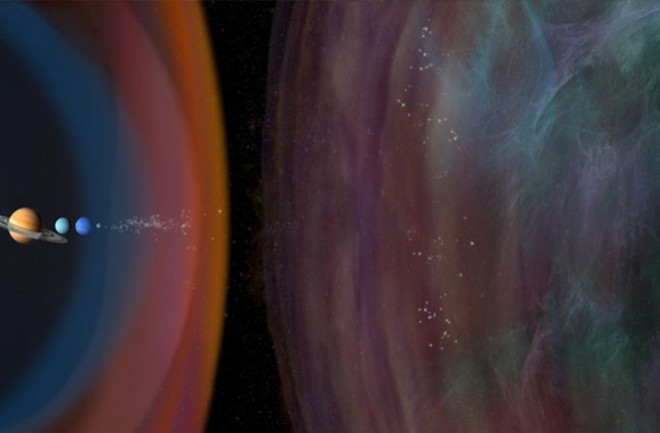
On October 31, 1936, six young tinkerers nicknamed the “Rocket Boys” nearly incinerated themselves in an effort to break free of Earth’s gravity. The group had huddled in a gully in the foothills of California’s San Gabriel Mountains to test a small alcohol-fueled jet engine. They wanted to prove that rocket engines could venture into space, at a time when such ideas were widely met with ridicule. That goal was disrupted when an oxygen line caught fire and thrashed around wildly, shooting flames.
The Rocket Boys’ audacity caught the attention of aerodynamicist Theodore von Karman, who already worked with two of them at Caltech. Not far from the location of their fiery mishap, he established a small test area where the Rocket Boys resumed their experiments. In 1943, the site became the Jet Propulsion Laboratory (JPL), and von Karman its first director. JPL has since grown into a sprawling NASA field center with thousands of employees, yet it has managed to retain its founding motivation: test the limits of exploration, convention be damned.
They’ve had many successes over the years. In the early 1970s, JPL engineers built Pioneer 10, the first spacecraft to reach escape velocity from the solar system. A few years later, they followed up with Voyagers 1 and 2, the fastest of the many objects aimed at interstellar space. From the beginning of the Space Age to the launch of the Voyager spacecrafts — a span of just two decades — rocket scientists more than doubled flight speeds. But in the decades since, only one more spacecraft has followed the Voyagers out of the solar system, and nothing has done so at such a high speed. Now JPL’s rocketeers are getting restless again, and quietly plotting the next great leap.
The consistent theme of the new efforts is that the solar system is not enough. It is time to venture beyond the known planets, on toward the stars. John Brophy, a flight engineer at JPL, is developing a novel engine that could accelerate space travel by another factor of 10. Leon Alkalai, a JPL mission architect, is plotting a distant journey that would begin with an improbable, Icarus-esque plunge toward the sun. And JPL research scientist Slava Turyshev has perhaps the wildest idea of all, a space telescope that could provide an intimate look at a far-off Earth-like planet — without actually going there.
These are all long shots (not entirely crazy, according to Brophy), but if even one succeeds, the implications will be huge. The Rocket Boys and their ilk helped launch humans as a space-faring species. The current generation at JPL could be the ones to take us interstellar.
Rocket Reactions
For Brophy, inspiration came from Breakthrough Starshot, an extravagantly bold project announced in 2016 by the late Stephen Hawking and Russian billionaire Yuri Milner. The ultimate aim of the project is to build a mile-wide laser array that could blast a miniature spacecraft to 20 percent the speed of light, allowing it to reach the Alpha Centauri star system (our closest stellar neighbor) in just two decades.
Brophy was skeptical but intrigued. Ambitious aspirations are nothing new for him. “JPL encourages people to think outside the box, and my wacky ideas are getting wackier in time,” he says. Even by that standard, the Starshot concept struck him as a little too far from technological reality. But he did begin to wonder if he could take the same concept but scale it down so that it might actually be feasible within our lifetimes.
What especially captivated Brophy was the idea of using a Starshot-style laser beam to help deal with the “rocket equation,” which links the motion of a spacecraft to the amount of propellant it carries. The rocket equation confronts every would-be space explorer with its cruel logic. If you want to go faster, you need more fuel, but more fuel adds mass. More mass means you need even more fuel to haul around that extra weight. That fuel makes the whole thing heavier still, and so on. That’s why it took a 1.4 million-pound rocket to launch the 1,800-pound Voyager probes: The starting weight was almost entirely fuel.
Since his graduate student days in the late 1970s, Brophy has been developing a vastly more efficient type of rocketry known as ion propulsion. An ion engine uses electric power to shoot positively charged atoms (called ions) out of a thruster at high velocity. Each atom provides just a tiny kick, but collectively they can push the rocket to a much greater velocity than a conventional chemical rocket. Better yet, the power needed to run the ion engine can come from solar panels — no heavy onboard fuel tanks or generators required. By squeezing more speed out of less propellant, ion propulsion goes a long way toward taming the rocket equation.
But ion engines come with drawbacks of their own. The farther they get from the sun, the more limited they are by how much electricity their solar panels can generate. You can make the panels huge, but then you add a lot of weight, and the rocket equation slams you again. And ion engines have such gentle thrust that they can’t leave the ground on their own; it then takes them a long time in space to accelerate to their record-breaking speeds. Brophy knows these issues well: He helped design the ion engine aboard NASA’s Dawn spacecraft, which just completed an 11-year mission to asteroid Vesta and dwarf planet Ceres. Even with its formidable 65-foot span of solar cells, Dawn went from zero to 60 in an unhurried four days.
Ion the Prize
While Brophy was pondering this impasse between efficient engines and insufficient solar power, the Breakthrough Starshot concept came out, and it got the gears turning in his head. He wondered: What if you replaced sunshine with a high-intensity laser beam pointed at your spacecraft? Powered by the more efficient laser, your ion engine could run much harder while still saving weight by not having to carry your power source on board.
Two years after his epiphany, Brophy is giving me a tour of an SUV-size test chamber at JPL, where he puts a high-performance ion engine through its paces. His prototype uses lithium ions, which are much lighter than the xenon ions Dawn used, and therefore need less energy to attain higher velocities. It also runs at 6,000 volts compared with Dawn’s 1,000 volts. “The performance of this thing would be very startling if you had the laser to power it up,” he says.
There’s just one minor issue: That laser does not exist. Although he drastically downsized the Starshot concept, Brophy still envisions a 100-megawatt space-based laser system, generating 1,000 times more power than the International Space Station, aimed precisely at a fast-receding spacecraft. “We’re not sure how to do that,” he concedes. It would be by far the biggest off-world engineering project ever undertaken. Once built, though, the array could be used over and over, with different missions, as an all-purpose rocket booster.
As an example, Brophy describes a lithium-ion-powered spacecraft with 300-foot wings of photovoltaic panels powering a full-size version of the engine he is developing at JPL. The laser would bathe the panels in light a hundred times as bright as sunshine, keeping the ion engine running from here to Pluto, about 4 billion miles away. The spacecraft could then coast along on its considerable velocity, racking up another 4 billion miles every year or two.
At that pace, a spacecraft could rapidly explore the dim areas where comets come from, or set off for the as-yet-undiscovered Planet 9, or go ... almost anywhere in the general vicinity of the solar system.
“It’s like we have this shiny new hammer, so I go around looking for new nails to pound in,” Brophy says dreamily. “We have a whole long list of missions that you could do if you could go fast.”
Interstellar Medium Well
After Brophy’s genial giddiness, it is a shock to talk to Alkalai, in charge of formulating new missions at JPL’s Engineering and Science Directorate. Sitting in his large, glassy office, he seems every bit the no-nonsense administrator, but he, too, is a man with an exploratory vision.
Like Brophy, Alkalai thinks the Breakthrough Starshot people have the right vision, but not enough patience. “We’re nowhere near where we need to be technologically to design a mission to another star,” he says. “So we need to start by taking baby steps.”
Alkalai has a specific step in mind. Although we can’t yet visit another star, we can send a probe to sample the interstellar medium, the sparse gas and dust that flows between the stars.
“I’m very interested in understanding the material outside the solar system. Ultimately, we got created from that. Life originated from those primordial dust clouds,” Alkalai says. “We know that there’s organic materials in it, but what kind? What abundances? Are there water molecules in it? That would be huge to understand.”
The interstellar medium remains poorly understood because we can’t get our hands on it: A constant blast of particles from the sun — the solar wind — pushes it far from Earth. But if we could reach beyond the sun’s influence, to a distance of 20 billion miles (about 200 times Earth’s distance from the sun), we could finally examine, for the first time, pristine samples of our home galaxy.
Alkalai wants answers, and he wants to see the results firsthand. He’s 60, so that sets an aggressive schedule — no time to wait for giant space lasers. Instead, he proposes a simpler, albeit still unproven, technology known as a solar thermal rocket. It would carry a large cache of cold liquid hydrogen, protected somehow from the heat of the sun, and execute a shocking dive to within about 1 million miles of the solar surface. At closest approach, the rocket would let the intense solar heat come pouring in, perhaps by jettisoning a shield. The sun’s energy would rapidly vaporize the hydrogen, sending it racing out of a rocket nozzle. The combined push from the escaping hydrogen, and the assist from the sun’s own gravity, would let the ship start its interstellar journey at speeds up to 60 miles per second, faster than any human object yet —and it only gets faster from there.
“It’s very challenging, but we’re modeling the physics now,” Alkalai says. He hopes to begin testing elements of a thermal-rocket system this year, and then develop his concept into a realistic mission that could launch in the next decade or so. It would reach the interstellar medium another decade after that. In addition to sampling our galactic environment, such a probe could examine how the sun interacts with the interstellar medium, study the structure of dust in the solar system and perhaps visit a distant dwarf planet along the way.
It would be a journey, Alkalai says, “like nothing we’ve done in the past.”
Catch A Glimpse
Solar thermal rockets and laser-ion engines, impressive as they may be, are still absurdly inadequate for crossing the tremendous gulf between our solar system and exoplanets — planets orbiting other stars. In the spirit of the Rocket Boys, Turyshev is not letting absurdity stop him. He is developing a cunning workaround: a virtual mission to another star.
Turyshev tells me he wants to send a space telescope to a region known as the solar gravitational lens (SGL). The area begins a daunting 50 billion miles away, though that’s still hundreds of times closer than our closest stellar neighbors. Once you get far enough into the SGL, something marvelous happens. When you look back toward the sun, any object directly behind it appears stretched out, forming a ring, and hugely magnified. That ring is the result of our star’s intense gravity, which warps space like a lens, altering the appearance of the distant object’s light.
If you position yourself correctly within the SGL, the object being magnified from behind the sun could be an intriguing exoplanet. A space telescope floating at the SGL, Turyshev explains, could then maneuver around, sampling different parts of the light ring and reconstructing the snippets of bent light into megapixel snapshots of the planet in question.
I have to interrupt him here. Did he say megapixel, like the resolution you get on your camera phone? Yes, he really is talking about an image measuring 1,000 by 1,000 pixels, good enough to see details smaller than 10 miles wide on a planet up to 100 light-years (600 trillion miles!) away.
“We could peek under the clouds and see continents. We could see weather patterns and topography, which is very exciting,” Turyshev says. He doesn’t mention it, but he doesn’t need to: That kind of resolution could also reveal megacities or other giant artificial structures, should they exist.
Assuming the JPL boffins can solve the transportation issues of getting to the SGL, the mission itself is fairly straightforward, if enormously challenging. Turyshev and his collaborators (Alkalai among them) will need to develop a Hubble-size space telescope,
or a mini-fleet of smaller telescopes, that can survive the 30-year journey. They will need to perfect an onboard artificial intelligence capable of running operations without guidance from home. Above all, they will need a target — a planet so intriguing that people are willing to spend decades and billions of dollars studying it. NASA’s TESS space telescope is doing some of that reconnaissance work right now, scanning for Earth-size worlds around local stars.
“Ultimately, to see the life on an exoplanet, we will have to visit. But a gravity lens mission allows you to study potential targets many decades, if not centuries, earlier,” Turyshev says merrily.
A journey to the SGL would take us beyond Alkalai’s baby steps, well onto the path toward interstellar exploration. It’s another audacious goal, but at least the odds of catching fire are much lower this time around.
Corey S. Powell , a contributing editor of Discover , also writes for the magazine's Out There blog. Follow him on Twitter: @coreyspowell. This story originally appeared in print as "Boldly Go."
- space exploration
- human spaceflight
Already a subscriber?
Register or Log In

Keep reading for as low as $1.99!
Sign up for our weekly science updates.
Save up to 40% off the cover price when you subscribe to Discover magazine.

- April 24, 2024 | Scientists Turn to Venus in the Search for Alien Life
- April 24, 2024 | NASA Astronauts Enter Quarantine As Boeing Starliner Test Flight Approaches
- April 23, 2024 | Peeking Inside Protons: Supercomputers Reveal Quark Secrets
- April 23, 2024 | A Cheaper and More Sustainable Lithium Battery: How LiDFOB Could Change Everything
- April 23, 2024 | Rewiring Reality: Stanford Unveils the Brain’s Fault Lines in Psychosis
Interstellar Travel: Magnetic Fusion Plasma Engines Could Carry Us Across the Solar System and Beyond
By Matt Williams, Universe Today October 22, 2023
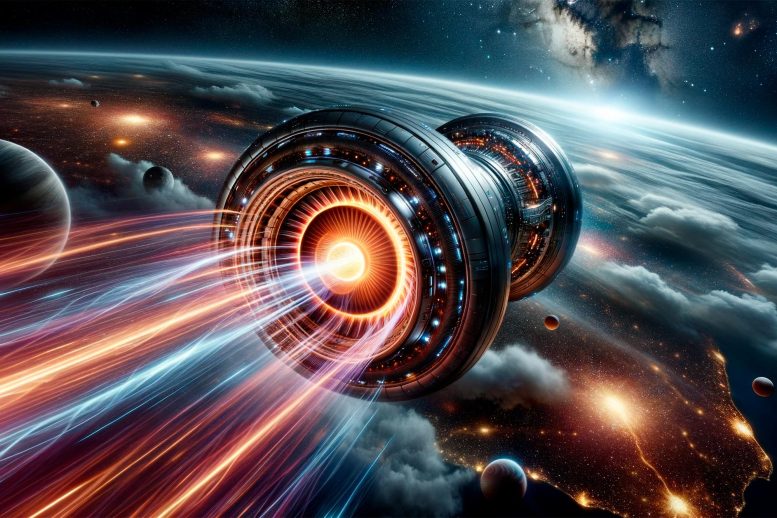
Florian Neukart, an Assistant Professor at the Leiden Institute, has proposed the Magnetic Fusion Plasma Drive (MFPD) as a novel space propulsion method. This concept combines fusion propulsion, ionic propulsion, and more, promising high energy density and fuel efficiency.
Florian Neukart introduces the Magnetic Fusion Plasma Drive, a revolutionary propulsion method combining fusion and ionic techniques. Offering immense energy density and numerous advantages, it could redefine space exploration, although challenges in sustaining fusion reactions in space remain.
Missions to the Moon, missions to Mars , robotic explorers to the outer Solar System, a mission to the nearest star, and maybe even a spacecraft to catch up to interstellar objects passing through our system. If you think this sounds like a description of the coming age of space exploration, then you’d be correct! At this moment, there are multiple plans and proposals for missions that will send astronauts and/or probes to all of these destinations to conduct some of the most lucrative scientific research ever performed. Naturally, these mission profiles raise all kinds of challenges, not the least of which is propulsion.
Simply put, humanity is reaching the limits of what conventional (chemical) propulsion can do. To send missions to Mars and other deep space destinations, advanced propulsion technologies are required that offer high acceleration (delta-v), specific impulse ( I sp ), and fuel efficiency. In a recent paper, Leiden Professor Florian Neukart proposes how future missions could rely on a novel propulsion concept known as the Magnetic Fusion Plasma Drive (MFPD). This device combines aspects of different propulsion methods to create a system that offers high energy density and fuel efficiency significantly greater than conventional methods.
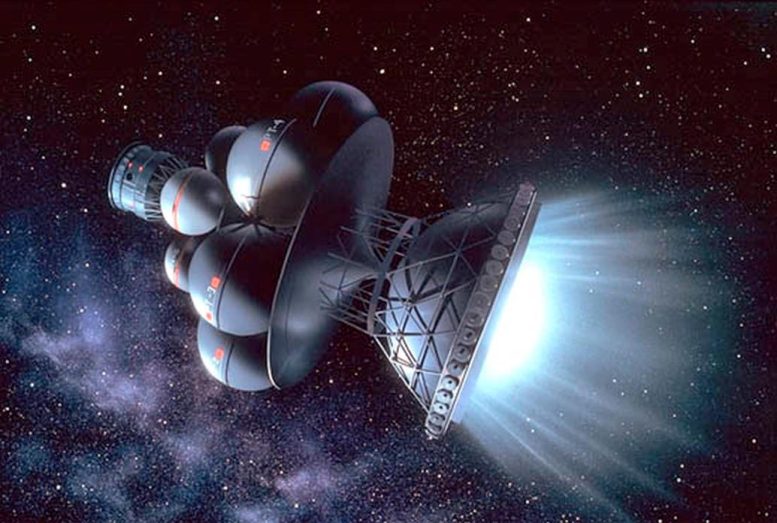
What will it take before human beings can travel to the nearest star system within their own lifetimes? Credit: Shigemi Numazawa/ Project Daedalus
Florian Neukart is an Assistant Professor with the Leiden Institute of Advanced Computer Science (LIACS) at Leiden University and a Board Member of the Swiss quantum technology developer Terra Quantum AG . The preprint of his paper recently appeared online and is being reviewed for publication in Elsevier .
Why the Need for Advanced Propulsion?
According to Neukart, technologies that can surmount conventional chemical propulsion (CCP) are paramount in the present era of space exploration. In particular, these technologies must offer greater energy efficiency, thrust, and capability for long-duration missions.
This is especially true for missions to Mars and other locations beyond the Earth-Moon system, which pose serious risks to astronaut health, safety, and well-being. Even when Earth and Mars are at their closest every 26 months (a Mars Opposition ), it can take up to 9 months to make a one-way transit to the planet. Combined with surface operations that could last up to a year and the nine-month return trip, missions to Mars could last up to 900 days! During this time, astronauts will be exposed to elevated levels of cosmic and solar radiation, not to mention the toll of long periods spent in microgravity will have on their bodies.
Hence, NASA and other space agencies are actively investigating alternate means of propulsion. As noted in a previous article, “ How Long Would It Take To Travel To The Nearest Star? ,” these concepts are also considered potential means for achieving interstellar travel for decades. They include fuel-efficient concepts like electric or ion propulsion, which utilize electromagnetic fields to ionize inert propellant (like xenon gas) and accelerate it through nozzles to generate thrust. However, these concepts generally produce low thrust and must rely on heavy power sources (solar arrays or nuclear reactors) to generate more.
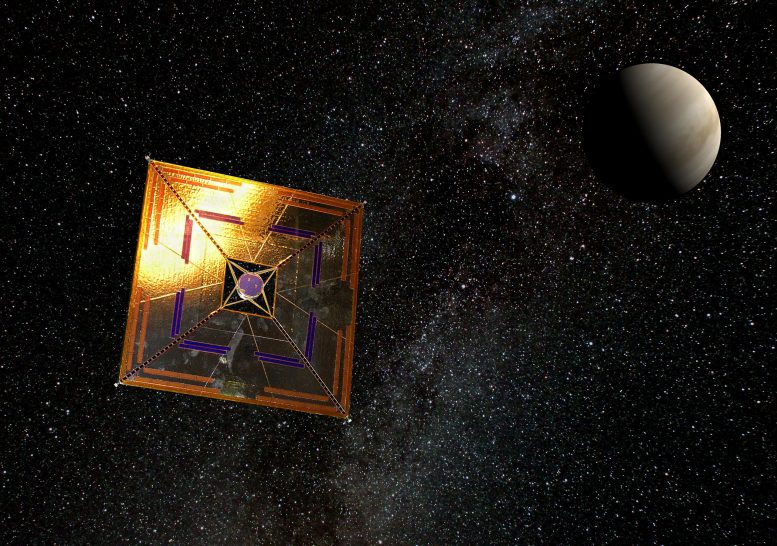
Artist’s depiction of the IKAROS spaceprobe ( the first spacecraft to successfully demonstrate solar sail technology in interplanetary space) in flight. Credit: Andrzej Mirecki
Solar Sails are another option, which can generate continuous acceleration while requiring no propellant (thereby saving on mass). However, missions equipped with this technology are limited in terms of thrust and must operate closer to the Sun. A twist on the idea is to employ Gigawatt-energy (GWe) laser arrays to accelerate spacecraft equipped with sails to relativistic speeds (a fraction of the speed of light). However, this concept requires expensive infrastructure and tremendous amounts of power in order to be feasible.
Nuclear and Fusion Propulsion
Another popular concept is nuclear thermal propulsion (NTP), which NASA and DARPA are currently developing in the form of the Demonstration Rocket for Agile Cislunar Operations (DRACO). This method relies on a nuclear reactor to heat propellant (like liquid hydrogen), causing it to expand through nozzles to generate thrust. The benefits of NTP include very high energy density and significant acceleration, but it also comes with numerous technical and safety challenges involving the handling and launching of nuclear materials.
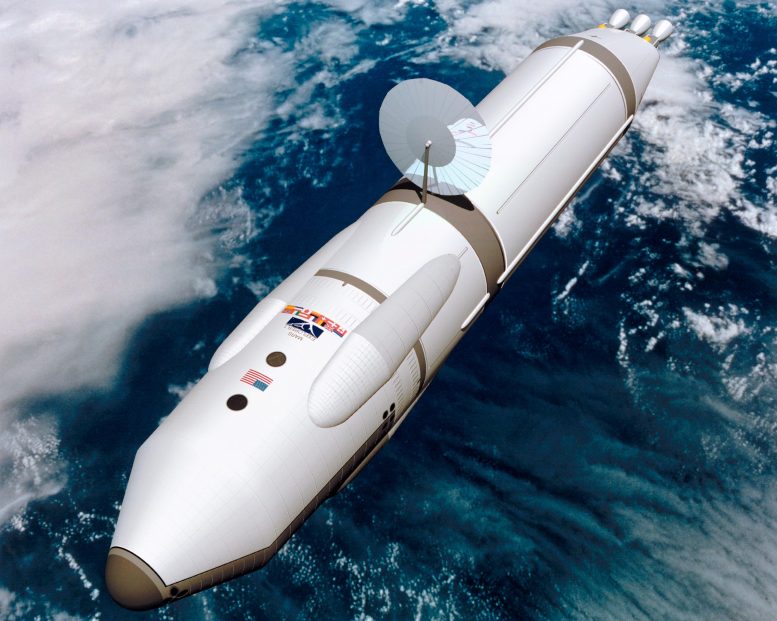
A spacecraft powered by a positron reactor would resemble this artist’s concept of the Mars Reference Mission spacecraft. Credit: NASA
There are also propulsion concepts that harness fusion reactions, like Deuterium-Tritium (D-T) and Deuterium-Helium three (D-He3) reactions, something that theoretical scientists have been working with for decades. These methods offer the potential for high thrust and extremely high specific impulse but also present technical challenges, not the least of which are related to handling the necessary fuel and achieving sustained and controlled fusion reactions. There are also more exotic concepts, like antimatter propulsion and the Alcubierre Warp Drive, but none of these will be available in the foreseeable future.
Neukart’s Revolutionary Concept
And there’s Neukart’s proposal, which combines elements of fusion propulsion, ionic propulsion, and other concepts. As he explained to Universe Today via email:
“The MFPD is a propulsion system for space exploration, utilizing controlled nuclear fusion reactions as a primary energy source for both thrust and potential electric power generation. The system is predicated on harnessing the immense energy output from fusion reactions, typically involving isotopes of hydrogen or helium, to produce a high-velocity exhaust of particles, thereby generating thrust according to Newton’s third law.
“The plasma from the fusion reactions is confined and manipulated using magnetic fields, ensuring controlled energy release and directionality. Simultaneously, the MFPD concept envisages the possibility of converting part of the fusion energy into electrical power to sustain onboard systems and possibly the reaction control system of the spacecraft.”
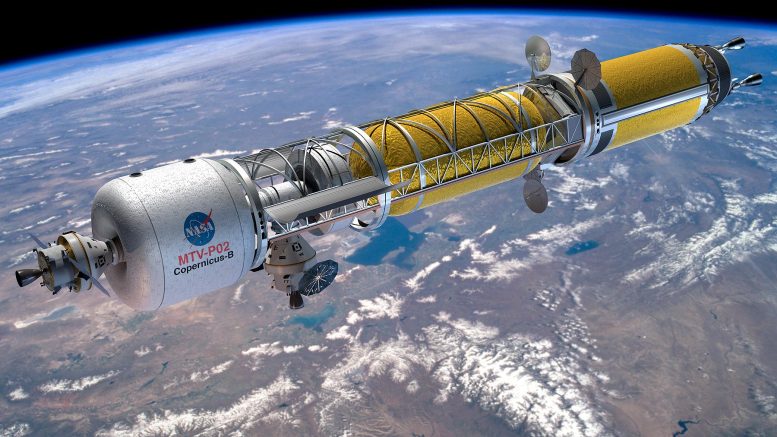
Artist’s concept of a Bimodal Nuclear Thermal Rocket in Low Earth Orbit. Credit: NASA
To develop this concept, Nuekart began with deuterium-tritium (D-T) fusion reactions since it is one of the most researched and understood reactions and offers a clear and familiar basis for elaborating the core principles and mechanics of MFPD. Furthermore, Neukart added, D-T reactions have relatively low ignition temperatures and a higher cross-section than other concepts, making it a good “starting point.” Therefore, they provide a useful benchmark for measuring and comparing the performance of this theoretical propulsion system.
However, the ultimate goal of MFPD is to harness aneutronic fusion (p-B11), where very little of the energy released by the reactions is carried by neutrons. Aneutronic reactions, in contrast, release energy in the form of charged particles (typically protons or alpha particles), thereby significantly reducing the level of neutron radiation produced.
Advantages of MFPD
The advantages of this system are immediately apparent, combining high specific impulse and immense energy density and providing both thrust and power from a single energy source. Other benefits, said Neukert, include the following:
- High Specific Impulse: The MFPD can provide a high-specific impulse, delivering substantial velocity change (delta-v) to the spacecraft, facilitating missions to distant celestial bodies.
- Energy-Dense Fuel: Fusion fuel, like isotopes of hydrogen, is incredibly energy-dense, potentially enabling extended missions without needing vast amounts of propellant.
- Lower Mass Fractions: The spacecraft might be designed with lower mass fractions dedicated to fuel storage, affording more mass allocation for scientific instruments or additional technologies.
- Dual Utility: The MFPD is not just a propulsion system; it is also envisioned to provide electrical power for the spacecraft’s systems and instruments, which is crucial for long-duration missions.
- Adaptability: The potential to adjust the thrust and specific impulse, offering versatility for different mission phases, such as acceleration, cruising, and deceleration.
- Reduced Travel Time: The potential for higher continuous thrust may significantly reduce transit times to distant destinations, mitigating risks related to cosmic radiation exposure and onboard resource management.
- Radiation Shielding: Although challenging, the inherent magnetic and physical structures might be engineered to provide some level of radiation shielding for the spacecraft and crew, utilizing the plasma and magnetic fields.
- Independence from Solar Proximity: Unlike solar sails or solar electric propulsion, the MFPD does not depend on proximity to the Sun; thus, it is viable for missions into the outer solar system and beyond.
- Minimized Risk of Nuclear Contamination: Compared to nuclear-thermal or fission-electric concepts, the MFPD could be designed to minimize the risk of radioactive contamination, given that fusion, in general, requires less radioactive material and potentially allows for safer reactor shutdown.
Implications and Challenges
As to the implications this system could have for space exploration, Nuekart emphasized the ability to traverse vast cosmic distances in reduced timeframes, expanding mission profiles (fast transits to other planets in the Solar System and interstellar missions), mitigating the risks of long-duration space missions (exposure to radiation and microgravity), revolutionizing spacecraft design by providing propulsion and electrical power simultaneously, and enhancing human exploration capabilities.
Beyond that, he also foresees the potential for technological spin-offs in materials science, plasma physics, and energy production that could have applications here on Earth. The development of this system could also foster international collaborations, bringing experts and resources from multiple fields together to realize common exploratory objectives.
Of course, no next-generation technology proposal would be complete without some caveats and addendums. For instance, said Nuekart, the main challenge for MFPD propulsion lies in achieving and maintaining stable fusion relations in space. On Earth, researchers have made considerable progress with magnetic confinement (MCF) and inertial confinement fusion (ICF). The former involves Tokamok reactors using magnetic fields to confine fusion in the form of plasma, while the latter relies on lasers to compress and heat tablets of D-T fuel.
However, similar experiments have not been conducted in space, leading to questions about how the system will handle heat caused by reactions, the resulting radiation, and the structural implications for spacecraft. Nevertheless, the ball is already rolling on nuclear tests in space (the aforementioned DRACO demonstrator). Given the benefits of fusion propulsion, it’s not likely to remain on the drawing board for long. Ultimately, says Nuekart, the research into MFPD aims to establish a pathway that will lead to interplanetary and (someday) Interstellar exploration:
“While the journey to realize the MFPD concept will undeniably be layered with challenges and scientific hurdles, the potential payoff is monumental. Achieving reliable, effective, and efficient fusion propulsion could redefine the boundaries of achievable goals, propelling humanity into a new era of exploration, discovery, and understanding of the cosmos. The hope is that the research seeds curiosity, innovation, and determination among scientists, engineers, and explorers across the globe, charting the course toward our future among the stars.”
Adapted from an article originally published on Universe Today .
Reference: “Magnetic Fusion Plasma Drive” by Florian Neukart, 20 September 2023, Physics > General Physics . arXiv:2309.11524
More on SciTechDaily
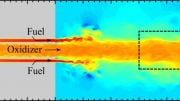
Dangerous Oscillations in Rocket Engines Driven by Fuel Flow and Heat Fluctuations

Earth and Mars Were Formed From Collisions of Large Bodies Made of Inner Solar System Material

Satellites and Drones Are Being Used To Study Glacial Physics and Predict Sea Level Rise

NASA Artemis I – Flight Day 25: Orion Spacecraft in Home Stretch of Journey
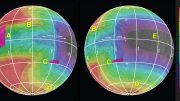
Researchers Assess the Surface of Europa for Materials Representing Ocean Composition

Increase in Guillain-Barré Syndrome Following AstraZeneca COVID-19 Vaccine

Discovering Inflammation’s Achilles Heel: The Breakthrough That Could Change Medicine

Biodegradable but Dangerous: The Hidden Environmental Hazards of Sugar Cane Plastic
15 comments on "interstellar travel: magnetic fusion plasma engines could carry us across the solar system and beyond".
What’s the difference between this and a fusion torch drive, which scientists have been discussing since at least the late 1960s?
An important development to MFPD and other variations would be to accelerate ionized plasma to relativistic speeds. This could be done by designing the craft to essentially being a particle accelerator in space. Generate ionized plasma, accelerate using magnetized array to near light speeds, then controlled release into space for propulsion. Configurations could be large rings (plasma in both clockwise and counter directions to equalize thrust), tighter helical cylinders, or other geometries that allow continuous and repeated acceleration of plasma. This may be why UAP (UFOs) are saucer or cylindrical in shape. Warp speed (Cochran) is another matter, but something that would make a Mars run in a day would be pretty cool and useful.
Polonium photonic 210 584004336573921005
Plenty of cool artistic depictions and nothing more. It’s a relief though ’cause mankind really NEEDS to stay grounded on this space rock. Once our filth and our greed and our utter disregard for the balance of nature gets scattered throughout the galaxy, it’ll be the end of the universe. We can’t restrain ourselves from destroying this planet…, how in the world will we exercise restraint when/ if we do succeed in interstellar travel?
We only have hydrogen and oxygen as a propellant. All other ionic propellants are science fiction at best.
Hydrazine, JP4, JP5, hydrogen peroxide and many others have been in use for years. And all of those are chemical reactions which don’t use much of the available energy. A fusion-based drive would kick things up a major notch.
It’s sad that you use DALLE3(AI) to generate your primary content image. Yes, it’s super obvious. It detracts from the credibility of the article and by extension the entire website.
I tend to agree with Alexander H&O are the most conventional propellants available for normal lenght/time movement. UFOs, if real, don’t use these materials, from what we’ve ever seen. They appear to ‘go’ by using field modification controlled by ? Electro-magnetics? and features of the physical world which we’ve only talked about. Things like ‘worm-holes’ or they artist’s depiction of the saucer sliding between the gravitational field lines. I’m sorry, at my advanced age, I cannot help to observe that time and distance are not absolutes. If I’m talking tensor lengths and time being speed depend, well then we are looking for methods for travel enhancement in the wrong intellectual place.
I understood about half of this article but could you use electromagnets for propulsion?
Adjusting the field strength to go faster.
Why are we still not looking in to creating our own magnet field as a shield for a space craft by spinning magnets with mercury..
I think we already have something like this in a black program. I witnessed a very large craft with 6 large ion or plasma engines fly right over my car one night Nov. 21, 2008, just east of Kingman AZ, on I40 near Exit 66 and the Pedco truck stop. Each engine was massive, about the size and shape of a drive-in movie screen. 3 across and 2 rows. They glowed purple blue and white. The haze stretched out behind it at least 50 yards. It seemed to be in trouble, it had sparks dripping from the front and electrical arcing across the bottom. It was only 200 feet or less above my car, based on the details I could see on the bottom and the size of the sparks. I also thought about the angle I was looking up, was like looking at the buildings in Los Angeles from the 110. So about 20 or 30 floors, 200 or 300 feet. I said to myself and laughed, “I hope its one of ours.” I have been looking for clues to how those engines could be made that big, I did see a NASA spokesman talking about stacking small ion engines together to make larger ones, just like they do to make jumbo TV screens for ballparks. Maybe that’s what I saw. A craft in trouble flying low to avoid radar and coming in for repairs. It was the biggest thing I have ever seen in the sky, and I worked on the C-17 in the 80’s. It was much bigger than that. If anyone else has seen anything like this with the glowing engines, pleasae reply.
I wonder about the possibility of multiple people having this information in their brain and not being important enough to be heard on the subject. I have neither the expertise nor the educational background to know any of this, yet I do. I have never known why… This question has plagued me. My design has never been developed publicly. Yet I have this knowledge and my design… of much of what is spoken of in this article. I have received a world of criticism (especially based upon my lack of knowledge in this/these fields… yet I know). I wonder if it’s time to collate all that is known on this field/area of knowledge, in the hope to reveal an answer to the simplest of quedtions: How?
Most of the comments here are wishful thinking but we need to start research in this direction or we’re never going to leave this solar system. As for U.F.O.s, government secrecy leads unwarranted speculation.
SciThechDaily keeps churning up articles about revolutionary inventions, game-changers and disruptors every day. If they all were true, we’d already be out there in the outer space, fighting Klingons.
Excellent literature above! THANK EVERYONE
Leave a comment Cancel reply
Email address is optional. If provided, your email will not be published or shared.
Save my name, email, and website in this browser for the next time I comment.
Interstellar Space Travel: 7 Futuristic Spacecraft to Explore the Cosmos
To the stars.
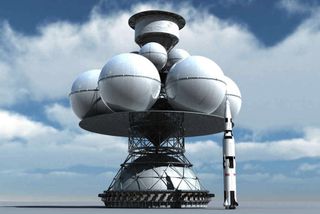
Astronomers recently announced strong evidence of an Earth-like alien planet around Proxima Centauri, the star closest to our sun, making it the closest exoplanet found to date . Though the star system is our cosmic neighbor, it is still located 4.2 light-years, or 25 trillion miles, away from Earth. At such distances, could we ever visit the newfound planet?
Even the nearest stars would takes tens of thousands of years to reach using conventional spacecraft, such as the robotic probes being used now to explore the solar system . These spacecraft are driven by a combination of chemical rockets, low-thrust ion drives and gravity-assisted trajectories — including so-called "slingshot maneuvers" around the sun or large planets that give them a big burst of speed.
But if we're going to travel beyond our solar system, we're going to need something a little faster than that — perhaps something like the giant Project Daedalus fusion rocket, shown here to scale with NASA’s Saturn V rocket in an illustration by graphical engineer and space artist Adrian Mann , whose work is featured in this countdown of futuristic space technologies. Here are seven ways that robots, or even human explorers, could visit the Proxima Centauri system or other cosmic neighborhoods.
Project Daedalus

Project Daedalus is a concept design for an interstellar probe, developed in the 1970s by a group of technical specialists for the British Interplanetary Society. The target destination was Barnard’s Star — a red dwarf about 6 light-years away, in many ways similar to Proxima Centauri, where astronomers now report they have found signs of a potentially habitable planet . When Project Daedalus was conceived, some astronomers thought a gas giant planet might be in orbit around Barnard's Star, but since then, no planets have been found in the star system.
The result of the five-year project was the design of the Daedalus spacecraft, a two-stage, 54,000-ton nuclear rocket that would boost a 400-ton robotic probe to around 12 percent of the speed of light. This would enable the probe to make the 6-light-year journey to Barnard’s Star in around 50 years.
The rockets of the Daedalus spacecraft would be powered by nuclear fusion, using electron beams to detonate a stream of pellets of fuel such as helium-3, which could be mined from the surface of the moon. Even so, the engines would consume tens of thousands of tons of fuel to get the spacecraft up to its top speed in about 4 years — and because there wouldn’t be any fuel left to slow down, the end result of the 50-year journey would be just a 70-hour flyby of the destination system, before the spacecraft speeds past into interstellar space.
The Daedalus would be much too large to lift off from the Earth’s surface, so it would have to be built in orbit, which means spacecraft like this couldn’t be built without a capacity for construction in space that doesn’t exist today, said space scientist Ian Crawford, a professor of planetary science and astrobiology at Birkbeck College in the United Kingdom.
While Crawford thinks the science behind the Project Daedalus concept is better understood now than when the spacecraft was designed, he said the immense cost and enormous technical challenges likely mean it would be more than 100 years before something like the Daedalus sets out for the stars.
Project Icarus

The Project Daedalus concepts from the 1970s are the inspiration for Project Icarus, an ongoing joint project by the British Interplanetary Society and the Icarus Interstellar organization, an international network of scientists, engineers and enthusiasts who hope to develop the capabilities for interstellar spaceflight by the year 2100.
Project Icarus is designed to reach any star within 22 light-years of Earth that has a potentially habitable exoplanet, meaning if a planet is confirmed around Proxima Centauri, it could become a target destination.
Project Icarus aims to update the Daedalus design with new technologies and ideas. Among the refinements proposed are fusion rocket engines that use a different nuclear fuel, which would be detonated by lasers instead of electron beams — a technology that could draw from recent advances in laser-ignition fusion at the National Ignition Facility at Lawrence Livermore National Laboratory in California, Crawford said.
The Icarus probe could also be smaller than the 400-ton probe envisioned for Project Daedalus, thanks to advances in electronic miniaturization and robotics, and future nanotechnologies — which would mean the spacecraft would need to carry less fuel to reach its full speed.

Our best bet for interstellar travel may be to not use a rocket at all, Crawford said. Light sails , which use the pressure of light to propel a payload, are already being considered for interplanetary space probes, and in 2010 Japan’s experimental IKAROS spacecraft successfully used its 60-foot-wide (20 meters) light sail to maneuver during a six-month journey to Venus.
But although light sails driven by sunlight are already an effective way to explore the solar system, they are not fast enough to cover interstellar distances in a reasonable amount of time.
Crawford said the answer may be to use powerful lasers to push the light sail to very high speeds with bursts of light at the start of the journey, until the spacecraft is too far from the laser source to gain more thrust from the light beam.
Since the driving lasers would be built on Earth or in orbit, interstellar light-sail spacecraft would not need to carry fuel for the journey, and so the mass of the spacecraft could be kept small.
Laser-driven light sail spacecraft are the basis of the Breakthrough Starshot project that was announced this year by investor Yuri Milner and physicist Stephen Hawking. The project aims to build a working prototype by 2036 at a final mission cost of around $10 billion dollars.
The project envisages a swarm of around 1,000 stamp-size "StarChip" spacecraft, each weighing a few grams and attached to a light sail measuring 13 feet (4 m) across, which would be deployed from a "mothership" in orbit before being accelerated by ground-based lasers to speeds of around 15 to 20 percent the speed of light.
This would allow the spacecraft to make the 4-light-year journey to the Alpha Centauri system — a triple-star system that includes the star Proxima Centauri and its possible planet — in between 20 and 30 years.
The concepts behind the Breakthrough Starshot project have been studied by Philip Lubin, a professor of cosmology at the University of California, Santa Barbara, who says the biggest challenge remaining is to create sufficiently powerful lasers to drive the light sail spacecraft.
Bussard ramjet
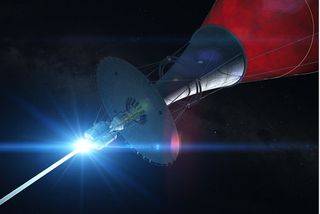
The Bussard Ramjet concept, proposed by physicist Robert Bussard in 1960, combines the high thrust of fusion rockets with the low fuel requirements of light sails.
Instead of carrying its own fuel, a Bussard Ramjet would scoop up the very thin traces of gas and dust found in interstellar space, known as the Interstellar Medium, using a vast funnel-shaped electromagnetic field that extends for thousands of miles in front of the spacecraft.
Hydrogen from the Interstellar Medium would then be compressed and used as fuel in a fusion rocket at the rear of the spacecraft that drives it forward.
In theory, a spacecraft driven by a Bussard Ramjet could continue to accelerate as long as there is enough interstellar gas in its path to provide enough thrust, and could reach a high fraction of the speed of light.
As a result, the venerable Bussard has seen long and honorable service in many works of science fiction, notably Larry Niven’s "Known Space" series of novels and short stories, including the "Ringworld" books; and the 1970 Poul Anderson novel "Tau-Zero" (Doubleday, 1970), in which an interstellar crew push their stricken Bussard spacecraft to relativistic speeds to avoid destruction.
Unfortunately, the Interstellar Medium around our solar system and the nearby stars is especially thin, and scientist have calculated that there’s just not enough hydrogen there to fuel a Bussard Ramjet. "It's not the ideal part of the galaxy," Crawford said.
But he explained that several ideas have been proposed to get around this limitation, including a concept known as a “Ram Augmented Stellar Rocket”, which uses collected matter as reaction mass to drive the spacecraft forward, using energy beamed to it by a laser; and an "Interstellar Runway," which would use deposits of fuel positioned in advance in the path of an accelerating Bussard spacecraft.
Antimatter rocket & black hole drive
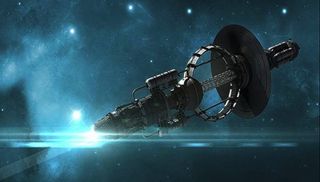
Beyond light sails, giant lasers and fusion rockets, a few even more exotic options for interstellar travel have been proposed, such as rockets powered by the extremely violent (and supremely efficient) annihilation reaction of matter and antimatter.
"Antimatter would be an excellent rocket fuel, because its energy density is so high," Crawford said. "But, of course it doesn't exist in nature, we have to make it. And it's very difficult and expensive to make, and very dangerous once you've made it — so who knows whether it could ever be used as a rocket fuel?"
Another proposal for using exotic physics to drive a spacecraft is the "Schwarzschild Kugelblitz" drive, which would use a microscopic, artificial black hole contained within its engines as its power source.
One idea for a ship equipped with the so-called "SK Drive," shown above, would trap Hawking radiation from the rapid and extremely violent decay of the tiny black hole, and convert it to energy that can be used it to propel the spacecraft.
Each of the artificial black holes would only survive for a few years, so new black holes would need to be created on demand, possibly by compressing pellets of matter with gamma-ray lasers.
According to a 2009 research paper , an SK-drive starship powered by a microscopic black hole with the mass of a modern supertanker could accelerate to 10 percent of the speed of light within 20 days. The black hole would last around 3.5 years before it decayed entirely, and would output more than 160 petawatts, or 160 quadrillion watts, of power in its lifetime.
Human "Slow Boats"
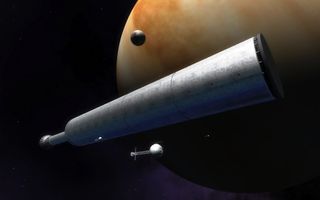
Even with super-fast rockets traveling at speeds of 10 percent or more of the speed of light, it would take many human lifetimes to reach all but the very nearest stars. And although Crawford is an advocate of human exploration of the solar system, he said that interstellar distances are too vast to make a human voyage conceivable within the next few hundred years.
"I think humans can explore the planets more effectively than robots, and I also think there are cultural reasons for sending humans into space, to broaden our range of experiences and enrich human culture," he said. "Now, it’s true that all of that would apply on the interstellar scale as well — it’s just that the distances are so large and the technical difficulties so great that advocating it at this stage is almost inconceivable."
Even so, several ideas exist for what are known as "Slow Boat" concepts that might one day take humans to the stars, including:
Sleeper Ships , in which human crewmembers are kept in a state of "deep sleep" or "suspended animation" for the duration of the very long voyage. This idea has featured in several science fiction movies, including Stanley Kubrick’s "2001: A Space Odyssey" made in 1969, Ridley Scott's "Alien" in 1979 and James Cameron's "Avatar" in 2009.
World Ships , also known as generation ships or interstellar arks, would be giant self-contained space habitats carrying large populations of humans and other species from Earth on a relatively leisurely journey to colonize exoplanets — journeys that would take many centuries to complete. Entire generations would live and die during the voyage, and only the descendants of the original population would arrive at the destination.
Embryo Ships would send cryogenically frozen embryonic humans, instead of sleeping or living humans, to a distant colony planet, where they would be "hatched out" and educated on their mission by a crew of protective robots.

Faster than light?

Wherever astronomers look in the universe, the Theory of Relativity holds fast. As Albert Einstein showed, it's not possible to accelerate a mass to the speed of light in space, nor past it.
But Einstein's equations may yet hold a few tricks that could someday let science do an end-run around the known laws of physics and achieve faster-than-light (FTL) travel — a Holy Grail for generations of science fiction fans.
The best known scientific concept for FTL travel is the Alcubierre drive, proposed by theoretical physicist Miguel Alcubierre in 1994.
The proposed drive operates by using intense gravitational forces, generated by two rotating rings of dense exotic matter, to shrink the physical dimensions of space in front of the spacecraft while expanding the space behind it, at a rate that could appear to exceed the speed of light.
In Alcubierre's proposal, which requires a type of exotic matter for the rings that is not known to exist, the spacecraft inside the "warp bubble" created by the drive would never travel faster than light in its local space, and so would not violate the laws of relativity.
Other speculative ideas for FTL travel include using trans-dimensional wormholes — also theoretically possible, but not known to exist — to travel between entangled but distant regions of space; or to daringly skim the edges of a large, spinning black hole, as depicted in Christopher Nolan’s 2014 movie "Interstellar."
But Crawford notes that the concept of faster-than-light travel is rife with unknowns and apparent contradictions, such as violating the principle of causality, in which events are caused by other events that happened earlier in time, and not the other way around. So, it's likely the proposals would prove impossible, even if they were technologically feasible to attempt.
"I don't want to sound overly pessimistic, because I can see huge benefits of being able to travel to the stars, but the laws of physics are the laws of physics, and it is going to be really difficult," Crawford said.
Sign up for the Live Science daily newsletter now
Get the world’s most fascinating discoveries delivered straight to your inbox.
Tom Metcalfe is a freelance journalist and regular Live Science contributor who is based in London in the United Kingdom. Tom writes mainly about science, space, archaeology, the Earth and the oceans. He has also written for the BBC, NBC News, National Geographic, Scientific American, Air & Space, and many others.
Explosive black hole flare from the center of our galaxy reconstructed from 'a single flickering pixel' using AI and Einstein's equations
4 solar flares simultaneously erupt from the sun in rare 'super' explosion — and Earth could be hit by the fallout
Ancient, 30-foot ancestor of great white shark unearthed in Mexico quarry
Most Popular
- 2 What's the largest waterfall in the world?
- 3 Global 'time signals' subtly shifted as the total solar eclipse reshaped Earth's upper atmosphere, new data shows
- 4 'Uncharted territory': El Niño to flip to La Niña in what could be the hottest year on record
- 5 Rare 'porcelain gallbladder' found in 100-year-old unmarked grave at Mississippi mental asylum cemetery
- 2 'I nearly fell out of my chair': 1,800-year-old mini portrait of Alexander the Great found in a field in Denmark
- 3 NASA reveals 'glass-smooth lake of cooling lava' on surface of Jupiter's moon Io
- 4 'We were in disbelief': Antarctica is behaving in a way we've never seen before. Can it recover?
- 5 Hundreds of emperor penguin chicks spotted plunging off a 50-foot cliff in 1st-of-its-kind footage

Is Interstellar Travel Really Possible?
Interstellar flight is a real pain in the neck.
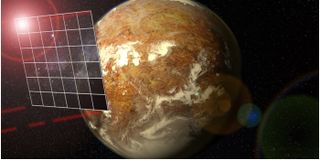
Paul M. Sutter is an astrophysicist at The Ohio State University , host of Ask a Spaceman and Space Radio , and author of " Your Place in the Universe. " Sutter contributed this article to Space.com's Expert Voices: Op-Ed & Insights .
Interstellar space travel . Fantasy of every five-year-old kid within us. Staple of science fiction serials. Boldly going where nobody has gone before in a really fantastic way. As we grow ever more advanced with our rockets and space probes, the question arises: could we ever hope to colonize the stars? Or, barring that far-flung dream, can we at least send space probes to alien planets, letting them tell us what they see?
The truth is that interstellar travel and exploration is technically possible . There's no law of physics that outright forbids it. But that doesn't necessarily make it easy, and it certainly doesn't mean we'll achieve it in our lifetimes, let alone this century. Interstellar space travel is a real pain in the neck.
Related: Gallery: Visions of Interstellar Starship Travel
Voyage outward
If you're sufficiently patient, then we've already achieved interstellar exploration status. We have several spacecraft on escape trajectories, meaning they're leaving the solar system and they are never coming back. NASA's Pioneer missions, the Voyager missions , and most recently New Horizons have all started their long outward journeys. The Voyagers especially are now considered outside the solar system, as defined as the region where the solar wind emanating from the sun gives way to general galactic background particles and dust.
So, great; we have interstellar space probes currently in operation. Except the problem is that they're going nowhere really fast. Each one of these intrepid interstellar explorers is traveling at tens of thousands of miles per hour, which sounds pretty fast. They're not headed in the direction of any particular star, because their missions were designed to explore planets inside the solar system. But if any of these spacecraft were headed to our nearest neighbor, Proxima Centauri , just barely 4 light-years away, they would reach it in about 80,000 years.
I don't know about you, but I don't think NASA budgets for those kinds of timelines. Also, by the time these probes reach anywhere halfway interesting, their nuclear batteries will be long dead, and just be useless hunks of metal hurtling through the void. Which is a sort of success, if you think about it: It's not like our ancestors were able to accomplish such feats as tossing random junk between the stars, but it's probably also not exactly what you imagined interstellar space travel to be like.
Get the Space.com Newsletter
Breaking space news, the latest updates on rocket launches, skywatching events and more!
Related: Superfast Spacecraft Propulsion Concepts (Images)
Speed racer
To make interstellar spaceflight more reasonable, a probe has to go really fast. On the order of at least one-tenth the speed of light. At that speed, spacecraft could reach Proxima Centauri in a handful of decades, and send back pictures a few years later, well within a human lifetime. Is it really so unreasonable to ask that the same person who starts the mission gets to finish it?
Going these speeds requires a tremendous amount of energy. One option is to contain that energy onboard the spacecraft as fuel. But if that's the case, the extra fuel adds mass, which makes it even harder to propel it up to those speeds. There are designs and sketches for nuclear-powered spacecraft that try to accomplish just this, but unless we want to start building thousands upon thousands of nuclear bombs just to put inside a rocket, we need to come up with other ideas.
Perhaps one of the most promising ideas is to keep the energy source of the spacecraft fixed and somehow transport that energy to the spacecraft as it travels. One way to do this is with lasers. Radiation is good at transporting energy from one place to another, especially over the vast distances of space. The spacecraft can then capture this energy and propel itself forward.
This is the basic idea behind the Breakthrough Starshot project , which aims to design a spacecraft capable of reaching the nearest stars in a matter of decades. In the simplest outline of this project, a giant laser on the order of 100 gigawatts shoots at an Earth-orbiting spacecraft. That spacecraft has a large solar sail that is incredibly reflective. The laser bounces off of that sail, giving momentum to the spacecraft. The thing is, a 100-gigawatt laser only has the force of a heavy backpack. You didn't read that incorrectly. If we were to shoot this laser at the spacecraft for about 10 minutes, in order to reach one-tenth the speed of light, the spacecraft can weigh no more than a gram.
That's the mass of a paper clip.
Related: Breakthrough Starshot in Pictures: Laser-Sailing Nanocraft to Study Alien Planets
A spaceship for ants
This is where the rubber meets the interstellar road when it comes to making spacecraft travel the required speeds. The laser itself, at 100 gigawatts, is more powerful than any laser we've ever designed by many orders of magnitude. To give you a sense of scale, 100 gigawatts is the entire capacity of every single nuclear power plant operating in the United States combined.
And the spacecraft, which has to have a mass no more than a paper clip, must include a camera, computer, power source, circuitry, a shell, an antenna for communicating back home and the entire lightsail itself.
That lightsail must be almost perfectly reflective. If it absorbs even a tiny fraction of that incoming laser radiation it will convert that energy to heat instead of momentum. At 100 gigawatts, that means straight-up melting, which is generally considered not good for spacecraft.
Once accelerated to one-tenth the speed of light, the real journey begins. For 40 years, this little spacecraft will have to withstand the trials and travails of interstellar space. It will be impacted by dust grains at that enormous velocity. And while the dust is very tiny, at those speeds motes can do incredible damage. Cosmic rays, which are high-energy particles emitted by everything from the sun to distant supernova, can mess with the delicate circuitry inside. The spacecraft will be bombarded by these cosmic rays non-stop as soon as the journey begins.
Is Breakthrough Starshot possible? In principle, yes. Like I said above, there's no law of physics that prevents any of this from becoming reality. But that doesn't make it easy or even probable or plausible or even feasible using our current levels of technology (or reasonable projections into the near future of our technology). Can we really make a spacecraft that small and light? Can we really make a laser that powerful? Can a mission like this actually survive the challenges of deep space?
The answer isn't yes or no. The real question is this: are we willing to spend enough money to find out if it's possible?
- Building Sails for Tiny Interstellar Probes Will Be Tough — But Not Impossible
- 10 Exoplanets That Could Host Alien Life
- Interstellar Space Travel: 7 Futuristic Spacecraft to Explore the Cosmos
Learn more by listening to the episode "Is interstellar travel possible?" on the Ask A Spaceman podcast, available on iTunes and on the Web at http://www.askaspaceman.com . Thanks to @infirmus, Amber D., neo, and Alex V. for the questions that led to this piece! Ask your own question on Twitter using #AskASpaceman or by following Paul @PaulMattSutter and facebook.com/PaulMattSutter .
Follow us on Twitter @Spacedotcom or Facebook .
Join our Space Forums to keep talking space on the latest missions, night sky and more! And if you have a news tip, correction or comment, let us know at: [email protected].

Paul M. Sutter is an astrophysicist at SUNY Stony Brook and the Flatiron Institute in New York City. Paul received his PhD in Physics from the University of Illinois at Urbana-Champaign in 2011, and spent three years at the Paris Institute of Astrophysics, followed by a research fellowship in Trieste, Italy, His research focuses on many diverse topics, from the emptiest regions of the universe to the earliest moments of the Big Bang to the hunt for the first stars. As an "Agent to the Stars," Paul has passionately engaged the public in science outreach for several years. He is the host of the popular "Ask a Spaceman!" podcast, author of "Your Place in the Universe" and "How to Die in Space" and he frequently appears on TV — including on The Weather Channel, for which he serves as Official Space Specialist.
Lego Star Wars Millennium Falcon (2024) review
Space-based solar power may be one step closer to reality, thanks to this key test (video)
Buried in the Cat's Paw Nebula lies one of the largest space molecules ever seen
Most Popular
- 2 Netflix releases official trailer for Jennifer Lopez mech combat sci-fi film 'Atlas' (video)
- 3 Ancient rocks hold proof of Earth's magnetic field. Here's why that's puzzling
- 4 Hubble telescope celebrates 34th anniversary with an iridescent Dumbbell Nebula (image)
- 5 The mystery of how strange cosmic objects called 'JuMBOs' went rogue

The U.S.S. Enterprise , depicted here in the 2013 movie Star Trek: Into Darkness , relies on its warp drive to zip across the galaxy.
Inside the Quest for a Real ‘Star Trek’ Warp Drive
It may be a while before starship captains can race across the galaxy, but engineers and physicists have a few ideas for making it so.
Within the Star Trek universe, traveling across the galaxy is a breeze thanks to the famed warp drive . This fictional technology allows humans and other civilizations to zoom between star systems in days rather than centuries.
Such rapid travel times are impossible in the real world, because our best theory for the way the universe works, Einstein’s special relativity , says that nothing moves faster than the speed of light.
While current rocket propulsion systems are bound by this law, plenty of hopeful engineers and physicists are working on concepts that might bring us a step closer to Star Trek ’s vision of racing across the cosmos.
“Currently, even the most advanced ideas behind interstellar travel entail trip times of decades and centuries to even the closest stars, due to the restrictions of special relativity, and our abilities—or lack of—to travel at an appreciable fraction of the speed of light,” says Richard Obousy , director and founder of Icarus Interstellar, a nonprofit dedicated to making progress toward interstellar flight.
“Being able to build starships with the capability to travel faster than the speed of light would open the galaxy for exploration and possible colonization by humans.”
Nuclear Engines
Distances in space are so vast that astronomers usually measure them in light-years, the distance light can travel in a year’s time. A single light-year equals about six trillion miles.
FREE BONUS ISSUE
The closest star to our solar system, Proxima Centauri, is 4.23 light-years away, so even traveling at the speed of light, a one-way voyage there would take 4.23 years. That may seem pokey, but it would be a huge improvement over current technology.
Right now, the fastest spacecraft headed away from Earth is Voyager 1, which is puttering along at about 38,600 miles an hour. At that rate, it would take more than 70,000 years to reach Proxima Centauri.
Still, various teams have proposed ways to at least reach a fraction of light speed and hasten our exploration of interstellar space.
Back in 1958, researchers at San Diego-based defense contractor General Atomics came up with Project Orion , which involved a spacecraft driven essentially by nuclear bombs. A controlled series of nuclear explosions would propel the ship at high speeds, rapidly carrying a hundred tons of cargo and eight astronauts to places like Mars and even the outer solar system.

Faster propulsion technology would allow us to visit our galactic neighbors, like this satellite of the Milky Way known as the Large Magellanic Cloud.
Blueprints were also created showing how to adapt the technology for interstellar travel. However, all experimentation with this so-called nuclear-pulse propulsion came to a halt with the Nuclear Test Ban Treaty of 1963.
Announced earlier this year, the ambitious Breakthrough StarShot initiative represents a less explosive effort to undertake an interstellar mission. Run by a conglomerate of billionaires and big thinkers, including famed physicist Stephen Hawking, the project’s goal is to send a flotilla of postage stamp-size spacecraft to Alpha Centauri, a triple star system that’s 4.3 light-years away. (See “Is the New $100 Million ‘Starshot’ for Real?” )
You May Also Like

U.S. returns to the moon as NASA's Odysseus successfully touches down

What is a sonic boom—and is it dangerous?

Why this company sent ancient human fossils into space
The tiny spacecraft would be attached to a thin light sail, a piece of technology that would allow mission managers to propel the probes with lasers shining from Earth’s orbit. The lasers would accelerate the craft to 20 percent the speed of light, and the probes would arrive at their destination in roughly 20 years.
While many of the tiny travelers may never make it to Alpha Centauri, a few of them should survive and may even fly past any planets orbiting the far-off stars , beaming back data about these alien worlds.
“I’m incredibly excited to see private money being used to explore breakthrough ideas that may advance the field of interstellar flight,” Obousy says.
“I hope to see more like this in the future. While there are engineering challenges associated with the Starshot Initiative, none appear insurmountable.”
Warping Reality
Of course, the real breakthrough would be a true warp drive, which requires technology to catch up with our theoretical designs.
In 1994, Trek fans got a glimmer of hope from Mexican theoretical physicist Miguel Alcubierre, who came up with a radical theory of hyper-fast space propulsion that doesn't break Einstein’s special relativity.
Instead of accelerating the spacecraft itself to light speed, why not bend, or warp, the fabric of space and time around the ship itself? Alcubierre presented calculations that produce a bubble in space-time in which one end is expanding and the other is contracting. A spaceship could, in theory, be carried along with the warp bubble and accelerated to velocities up to 10 times the speed of light.
While that sounds simple on paper, to make it work, we may need to harness exotic forms of matter, like antimatter, that for now are poorly understood. In addition, numerous unsolved issues plague the creation and control of a warp bubble, Obousy says.
“One such problem, for example, is the idea of causal disconnection, which implies that any spacecraft sitting within the bubble would not be able to ‘communicate’ with the exterior of the bubble, suggesting that a ship would not be able to ‘turn off’ the bubble once inside of it,” he notes.
As is often the case in space travel, developing true interstellar travel like what we see in Star Trek will require significant changes in the cost and energy requirements.
“Currently, the amount of energy and money required to entertain the notion of manned interstellar travel is measured in large fractions of global output—specifically, tens of trillions of dollars, and energy measured on the scale of what many large countries use annually,” he says.
Still, he adds, “the finest minds of the 15th century could not have predicted the technological wonders of the 21st century. Similarly, who are we to say what technology the humans of the 27th century will have mastered.”
Andrew Fazekas, the Night Sky Guy, is the author of Star Trek: The Official Guide to Our Universe and host of NG Live! " Mankind to Mars " presentations. Follow him on Twitter , Facebook , and his website .
Related Topics
- TELEVISION AND VIDEO

NASA has a plan to clean up space junk—but is going green enough?

Why go back to the moon? NASA’s Artemis program has even bigger ambitions

NASA smashed an asteroid with a rocket. The debris could hit Mars.

Noise pollution harms more than your hearing

Historic moon lander malfunctions after launch—but NASA isn’t panicked (yet)
- Environment
- Perpetual Planet
- History & Culture
History & Culture
- History Magazine
- Mind, Body, Wonder
- Paid Content
- Terms of Use
- Privacy Policy
- Your US State Privacy Rights
- Children's Online Privacy Policy
- Interest-Based Ads
- About Nielsen Measurement
- Do Not Sell or Share My Personal Information
- Nat Geo Home
- Attend a Live Event
- Book a Trip
- Inspire Your Kids
- Shop Nat Geo
- Visit the D.C. Museum
- Learn About Our Impact
- Support Our Mission
- Advertise With Us
- Customer Service
- Renew Subscription
- Manage Your Subscription
- Work at Nat Geo
- Sign Up for Our Newsletters
- Contribute to Protect the Planet
Copyright © 1996-2015 National Geographic Society Copyright © 2015-2024 National Geographic Partners, LLC. All rights reserved
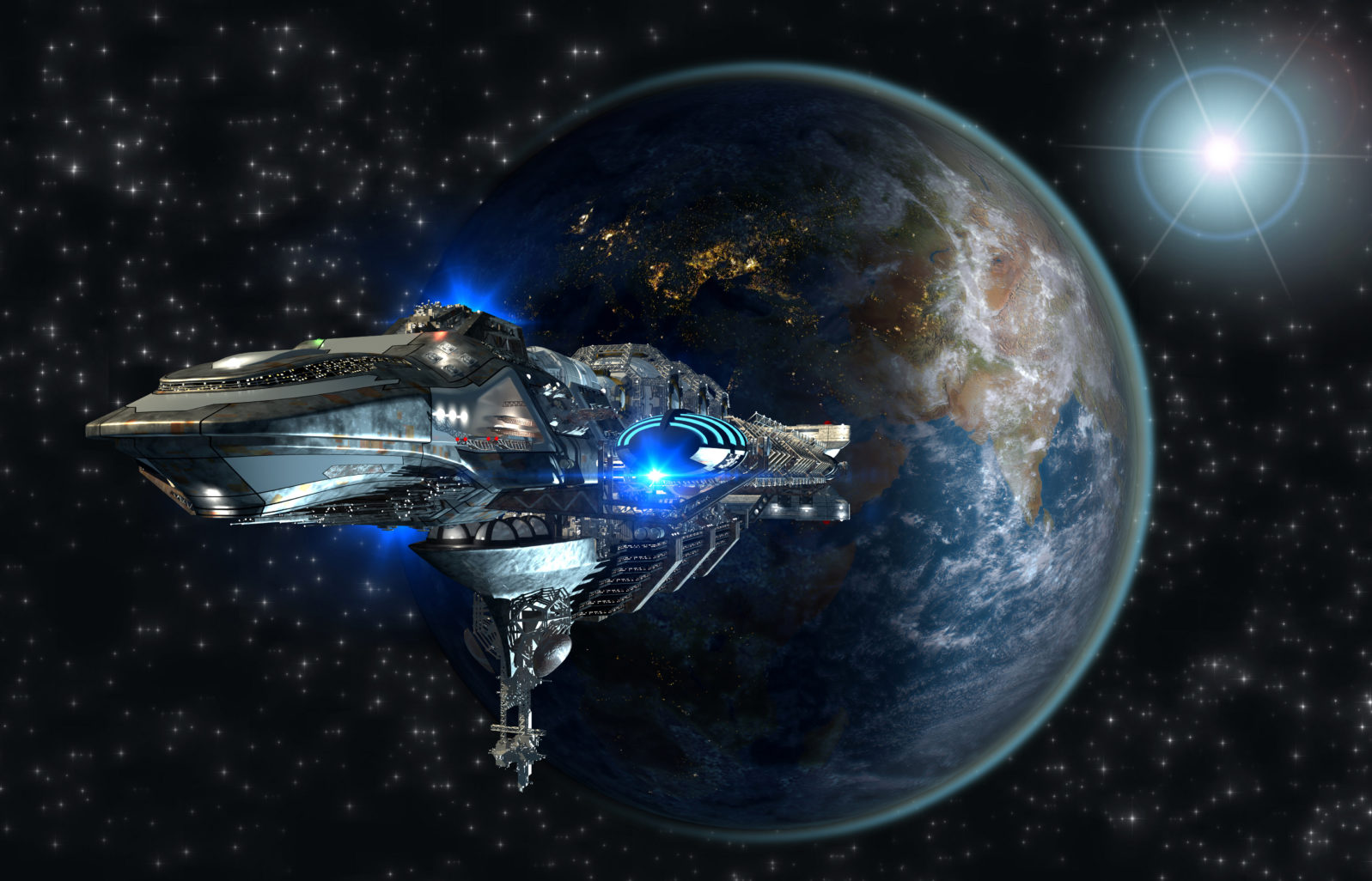
Interstellar Travel: The Four Top Technologies for Getting There
University of Rochester astrophysicist Adam Frank looks at the possibilities of interstellar travel, given the “insane scale” of the distances between stars and galaxies, in relation to space exploration, whether by ourselves or by intelligent extraterrestrials.

Science fiction usually starts with the assumption that the distance problem is somehow already solved. What real-world proposals are out there now for solving it? At Big Think, Frank offers four: Cryosleep, solar sails (or light sails), wormholes, and warp drives.
Cautioning that they may all be pipe dreams, he offers some thoughts.
Possibly the most intriguing is cryosleep:
Cryosleep technology would basically “freeze” the body’s metabolism (or at least slow it down) for the duration of the journey. Despite being a staple of science fiction, no one even has come close to getting this to work for higher animals (like mammals). Still, it is the kind of solution that doesn’t require magical new physics to exist — maybe just magical new biology. Also, if “post-biological” life is really a thing, then maybe some aliens switch to silicon-based machine forms, and thus the question of long timescales is no longer an issue. Adam Frank , “ The technology we (or aliens) need for long-distance interstellar travel ” at Big Think (November 18, 2021)
Researchers have had some luck with raising nematode worms (which survived a space shuttle explosion) and water bears in space conditions. But these life forms are naturally adapted to survive under conditions that would be lethal for most. We can’t extrapolate from them to humans without ignoring a lot of biology.
About the move to “silicon-based machine forms” — that’s one of the hypotheses as to why we don’t see extraterrestrials: the Aestivation Hypothesis. On this view, advanced life forms exist indefinitely but in a digitized form. In fact, some futurists think that technologically advanced life forms will usually transition to an ageless digitized existence.
But, of course, whether or not digital human travel in remote reaches of space is possible, that’s not what most of us would think of as interstellar travel anyway. We tend to picture ourselves — as, well, ourselves — speeding through galaxies. If we were digital, the galaxies we sped through might as well be our own digital creations anyway, as opposed to physical explorations of the physical world.
Frank also discusses solar sails which, if large and light enough, could use the energy from the sun or giant lasers to reach the speed of light, cutting the time taken to reach nearby stars from, centuries to decades. Trouble is, he notes, if we wanted to stop anywhere, we would need a similar device at the other end to slow it down.
He also discusses wormholes, as predicted by Einstein’s general relativity:
Wormholes are the kind of transport portrayed in Star Trek: Deep Space Nine The problem here, Frank says, is that we would need anti-gravity exotic matter (with negative mass) to keep the two mouths of the wormhole open. So far that exists only in a mathematical theory.
Some think the problem isn’t insurmountable though. Stony Brook astrophysicist Paul Sutter reported last week that a recent study contradicts earlier fears that wormhole shortcuts would immediately collapse: “it points out that wormholes aren’t quite as catastrophic as they first appeared, and that there may be stable paths through wormhole tunnels, perfectly allowed by general relativity.” (Space.com) Either way, it is very theoretical and on a very far horizon just now.
We encounter the same problem with warp drives, where a warp bubble in front of a spaceship bends spacetime. That technology, according to NASA, remains “at the level of speculation,” apart from science fiction (it’s a staple, of course, in Star Trek ).
Warp drives would require exotic matter too. They would also release huge shock waves, according to Frank (“this blast of energy would fry everything in your path and sterilize any planet you were visiting”).
While Frank is generally pessimistic, he doesn’t rule out the possibility that the strange physics of quantum mechanics will find a way around all this via a new theory of quantum gravity , which he discusses. Meanwhile, it’s fair to say that, while interstellar travel is not the Next Big Thing, the concepts around it are fascinating in themselves.
You may also wish to read: The Aurora Hypothesis: ET could risk only rare contact with us. Given the difficulties and risks of space travel, extraterrestrials with advanced technology may have visited Earth only one in a million years, researchers say. After centuries of modern science, we are just now looking for fossil bacteria on Mars, not without risk. ET may be in the same position. (Adam Frank was one of the astrophysicists who gave this hypothesis the name “Aurora.” )
- Apple Podcasts
- Androids, Robots, Drones, and Machines
- Apocalypticism, Dystopia, and the Singularity
- Applied Intelligence, Problem Solving, and Innovation
- Artificial Intelligence
- Automation, Jobs, and Training
- Government Policy
- Hype and Limits
- Mind, Brain, and Human Intelligence
- Natural Human, Animal, and Organismic Intelligence
- Philosophy of Mind
- Sci-fi Saturdays
- Social Factors
- Technocracy and Big Tech
- Transhumanism
- Contributors
- Jonathan Bartlett
- William A. Dembski
- Brendan Dixon
- Michael Egnor
- Winston Ewert
- Eric Holloway
- Erik J. Larson
- Robert J. Marks
- Denyse O’Leary
- Richard W. Stevens
- Gary Varner
- Heather Zeiger
- Subscribe to BBC Science Focus Magazine
- Previous Issues
- Future tech
- Everyday science
- Planet Earth
- Newsletters
From solar sails to hyperspace: Here’s the future of interstellar travel
Will it ever be possible to zip around the cosmos like Baby Yoda and co in The Mandalorian ? A physicist explains.
Stephen Kelly
Hyperspace travel – the ability for spaceships to travel as fast as the speed of light – is an integral part of the Star Wars universe.
The new series of The Mandalorian , for instance, would be quite a different show if Mando and Grogu had to wait 6,000 years to fly from one planet to the next.
But it does raise the question of just how feasible such technology is. Will we ever attain the ability to travel vast distances across space without having to burn through generations of astronauts? Or are we just marooned in our corner of the Galaxy?
To answer that, Prof Patrick Johnson , author of The Physics Of Star Wars , needs to be clear on what, exactly, hyperspace travel is.
“If we’re talking about the idea that spaceships in Star Wars accelerate forward as fast, or faster than, the speed of light, then that is not plausible,” he says.
“The speed of light is the speed limit of the Universe. Once you travel faster than light, cause and effect begin to break down. You could feasibly view an event happening five light-years away, travel faster than the speed of light towards it and get there before it happens. It’s basically time travel.”
A more realistic option, says Johnson, is that instead of ships in Star Wars accelerating at the speed of light, hyperdrive technology enables them to create a wormhole in order to travel from one point in space to another.
“It would be like folding a piece of paper and punching a hole through it so an ant can get to the other side,” he says.
It would also explain why, in certain hyperspace sequences in Star Wars , the ships look like they’re travelling through a blue tunnel. (Although, of course, there are also other scenes, such as Vice-Admiral Holdo flying a ship at light speed through another ship in The Last Jedi , that lend strength to the accelerating theory).

The problem with creating a wormhole, says Johnson, is that no one knows how to do it; it’s more theoretical than practical. “It would perhaps be easier to find a pre-existing wormhole and just hope it leads to somewhere you want to go,” he says.
“As for creating one, that would take decades’ worth of human energy. And that’s before we figure out how to target a particular location.”
Johnson also insists that any wormhole created would have to be far away from Earth.
“Going back to the paper analogy, it’s not going to end well for the ant if it happens to be in the spot where the pencil bursts through. You would need an empty, unoccupied part of space, along with incredibly complex calculations and some sort of up-to-date star map, to ensure that the planet you’re going to is in the right place.”
At this stage, both options seem as unlikely as each other, which means that we are stuck in our Solar System for the foreseeable future.
But Johnson lives in hope that, even if we can’t accelerate at light speed, we can develop ways to travel long distances across the Galaxy.
“Without hyperdrives, I’d say our best bet for getting far, far away in a reasonable amount of time is solar sail technology,” he says. “These would operate like wind sails, but instead use the light from a star to push the ship forward and essentially give it an unlimited supply of fuel. The acceleration would be small at first, but after 10 years you could get up to around 20 per cent of the speed of light, which is very good.”
Promising – but we wouldn’t book that holiday to Tatooine just yet.
About our expert
Patrick Johnson is an associate teaching professor at Georgetown University’s department of physics, and author of The Physics Of Star Wars . Earning his PhD at Washington University in St Louis, Johnson’s work on quantum mechanics has been published in Physical Review journal.
- Tardigrades could be the first interstellar space travellers
- What would faster-than-light (hyperspace) travel look like?
Share this article

- Terms & Conditions
- Privacy policy
- Cookies policy
- Code of conduct
- Magazine subscriptions
- Manage preferences

IMAGES
VIDEO
COMMENTS
The sun’s energy would rapidly vaporize the hydrogen, sending it racing out of a rocket nozzle. The combined push from the escaping hydrogen, and the assist from the sun’s own gravity, would let the ship start its interstellar journey at speeds up to 60 miles per second, faster than any human object yet —and it only gets faster from there.
Interstellar distances are vast, and extremely advanced technology will be required if we (or aliens) want to visit other star systems. Cryosleep, light sails, wormholes, and warp drives offer...
Interstellar Travel: Magnetic Fusion Plasma Engines Could Carry Us Across the Solar System and Beyond. TOPICS: Popular Transportation. By Matt Williams, Universe Today October 22, 2023. Florian Neukart, an Assistant Professor at the Leiden Institute, has proposed the Magnetic Fusion Plasma Drive (MFPD) as a novel space propulsion method.
Beyond light sails, giant lasers and fusion rockets, a few even more exotic options for interstellar travel have been proposed, such as rockets powered by the extremely violent (and supremely ...
The truth is that interstellar travel and exploration is technically possible. There's no law of physics that outright forbids it. But that doesn't necessarily make it easy, and it certainly...
Interstellar travel is the hypothetical travel of spacecraft from one star system, solitary star, or planetary system to another. Interstellar travel is expected to prove much more difficult than interplanetary spaceflight due to the vast difference in the scale of the involved distances.
Faster propulsion technology would allow us to visit our galactic neighbors, like this satellite of the Milky Way known as the Large Magellanic Cloud. Photograph by NASA, ESA. Blueprints were also...
University of Rochester astrophysicist Adam Frank looks at the possibilities of interstellar travel, given the “insane scale” of the distances between stars and galaxies, in relation to space exploration, whether by ourselves or by intelligent extraterrestrials. Adam Frank.
Now that the Voyagers are outside of the heliosphere, their new perspective will provide new information about the formation and state of our Sun and how it interacts with interstellar space, along with insight into how other stars interact with the interstellar medium.
From solar sails to hyperspace: Here’s the future of interstellar travel